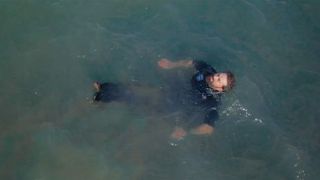Learn How To Float – It Might Save Your Life
Practice floating to avoid disaster if you’ll be near open water this summer

If you’re planning on heading to the UK’s coastline this summer, the last thing you’ll probably think of doing is brushing up on your survival skills. The hairest situation most people would expect to handle is facing down a chip thieving seagull, but it’s all too easy to get caught out by cold water – whether you planned on getting wet, fell in accidentally or took a spur of the moment decision to take the plunge.
That’s why the Royal National Lifeboat Institution (RNLI) is asking people to learn how to float in case you find yourself in trouble in the sea or other body of cold water. The RNLI are trying to reach men in particular, because 90% of the 115 people who died accidentally on the UK coast last year were men. If you’re about to brush off this advice because you’re the don’t feel the cold, wear shorts in winter type, let Ant Middleton, the type of man who steals chips from seagulls, set you straight.
The RNLI has a five step plan to use when you find yourself in danger in cold water. It’s especially important if you’ve dropped into the water unexpectedly, because suddenly hitting cold water can take your breath away and befuddle the senses, but the steps can also help you survive if you get yourself in a pickle while swimming, especially if you’ve been swept out to sea.
Here are the five steps, which are illustrated in detail on the Respect The Water website and also in the video below.
- Fight your instinct to thrash around
- Lean back, extend your arms and legs
- If you need to, gently move your arms and legs to help you float
- Float until you can control your breathing
- Only then, call for help or swim to safety
It’s smart to practise this in a safe environment like a swimming pool rather than simply reading the above and hoping it sticks. It’ll take just a few minutes in your local pool to get to grips with floating and it could save your life.
Get the Coach Newsletter
Sign up for workout ideas, training advice, reviews of the latest gear and more.

Nick Harris-Fry is a journalist who has been covering health and fitness since 2015. Nick is an avid runner, covering 70-110km a week, which gives him ample opportunity to test a wide range of running shoes and running gear. He is also the chief tester for fitness trackers and running watches, treadmills and exercise bikes, and workout headphones.

Coros Vertix 2S Review: The Garmin Fenix Rival Gets Some Useful Upgrades

I Tried CrossFit Champ Mat Fraser’s Signature 40-Minute EMOM And It Helped Me Build Strength, Skill And Endurance In One Fell Swoop

I Took A Test To Find Out If I Had What It Takes To Be An Elite Athlete And It’s Changed My Training For The Better